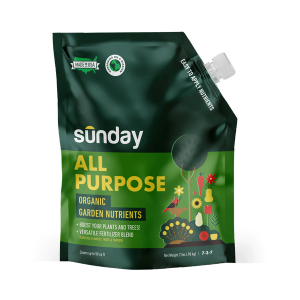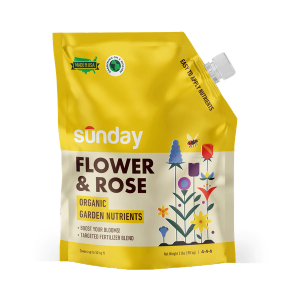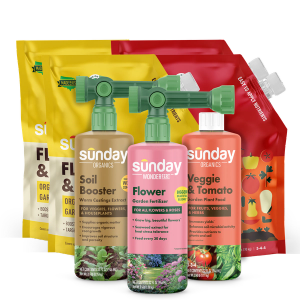The benefits of container gardens
For starters, your options are endless. Container gardens are ideal for growing anything from small herbs to larger flowers or even some fruit trees. The only limit to what you can grow? The size of the container. Keep in mind that it’s best to steer clear of extremely large trees or shrubs that are likely to outgrow the container. The flexibility of a container garden makes it perfect for growing in non-traditional settings like apartments, rooftops, porches, or even balconies. It’s also a great way to get your green thumb going no matter what your experience level.
Choose the right location
First, choose whether you’d like to grow your container garden indoors or out. If outdoors, your local nursery can help you determine which plants will thrive in your climate. If indoors, the selection is more broad but you should still seek advice from your local nursery. Next, determine how much sunlight your container will be exposed to in its location. The best locations have a good balance of sun, shade, and easy access to water.
How to pick a container
What comes first, the container or the plant? We recommend having a good container ready before purchasing any plants. For edible plants, make sure that you do not use any container that previously held toxic materials. Chemicals can leach from certain plastics, wood pallets, or treated and stained wood, so avoid building or reusing materials if you are unsure of toxicity levels.
Be sure that your container has proper drainage, and that its size and height are well-suited to the space you have available. It’s always best to use a pot that is durable and made well so that it’ll last for many growing seasons. Natural stone, terracotta, concrete, non-toxic plastic, metal, or untreated wood containers are all great options for planters.
How to pick your potting mix
Soil holds moisture, which is great in the ground, but in a container it can cause plants to become waterlogged. When a plant becomes waterlogged it can begin to rot from the roots up, which will eventually show as wilted, yellowing leaves. For better moisture control and increased drainage, we recommend choosing a potting mix that is clean (no pollutants like styrofoam), organic, and doesn’t include any harsh chemicals or ingredients.
For a good balance of moisture retention and proper drainage, we recommend adding compost and sand into your potting mix. It's also best to avoid mixes that contain fertilizers because it's hard to verify exactly how much the mixes contain—and how potent that fertilizer is. It's better to just add your own later so that you can know exactly what is going into each container.
Sunday Tip:
Interested in composting? Find out everything you need to know to get the most out of compost.
How to pick your plants
The first question when picking plants is whether to grow edible or non-edible plants. Both have their benefits, but whichever you choose, make sure to mix-up the color, texture, size, and shape of your container plants. Additionally, if you’re planting in a location that supports both, you can also consider mixing edible and non-edible species together.
For ornamental plants, try taking a thriller-filler-spiller approach to get the most out of each container.
- Thriller: Choose foliage or a flower that is a tall, dramatic centerpiece for your container. In general, it’s best to pick a “thriller” that is approximately two times as tall as the container. Placing the focal point in the center will help keep your container visually appealing from every angle.
- Filler: The main job of fillers is to make the container appear full. Be sure to surround your thriller (if center) or if you place your thriller at center-rear, then plant your fillers in the foreground.
- Spiller: For a container that is overflowing with beauty, add in some plants that hang over the edge of the container. Be sure to place plants near the edge of the pot to get the most spill-over from your plants.
For edible plants we recommend you follow your tastebuds, because the best vegetable to grow is the one that you want to eat. Most vegetables will do well in containers, given enough room to grow, but you can also look for varieties specifically labeled for container gardening. Most will need full sun (6–10 hours per day), so make sure to position vegetable containers in a bright spot. Leafy vegetables can tolerate some shade, but fruit and root crops won’t typically tolerate shade as well. Picking veggies can also be a fun family activity, and many veggies are great to grow with kids.
Sunday Tip:
If you are able to plant outdoors, we recommend choosing native plants. Local pollinators need local plants. Use your container garden to boost local pollinators.
How to care for your container gardens
Watering is an important part of every garden. For containers, start by checking the top inch of the potting mix. If it’s dry to the touch, then it's time to water. Be sure to ask your local nursery for any specific watering requirements when purchasing plants. And as always, be sure not to overwater!
Garden fertilizer can be applied when first planting the container and again throughout the growing season. A balanced fertilizer (equal ratios of N-P-K) will work just fine for most plants, though some people may choose higher quantities of phosphorus or potassium for fruiting and blooming plants. Be sure to use a good, clean fertilizer and follow the directions according to the label. Keep in mind that more is not necessarily better! It’s easy to burn your plant’s roots with fertilizer, so it’s always best to start with dilutions and work your way up.
Get your container garden growing
The best way to grow a beautiful garden is to just get growing. From native plants to grillable veggies, beautiful foliage is only a container away.
Cited sources
Bagged potting mixes and garden soils for home gardeners. University of Massachusetts Amherst.
Container gardening. University of Illinois Extension.
Container gardens. Colorado State University Extension.
Dealing with Waterlogged Soils. Kansas State University.
Growing Vegetables In Containers. New Hampshire State University Extension.
The art of container gardening. PennState Extension.
Toxicity Concerns about Raised Bed Construction Materials. Iowa State University Extension.
What is the best soil for potted plants? University of New Hampshire Cooperative Extension.



















